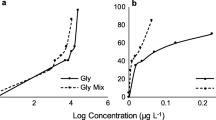Abstract
Individual and joint toxicity of three chloroacetanilide herbicides to a freshwater cladoceran were studied. The 48 h-LC50 values of alachlor, acetochlor and butachlor to Daphnia carinata Dc42 were 11.1, 11.8 and 3.45 mg L−1, respectively. The toxicity was significantly (p < 0.05) related to hydrophobicity. The additive indexes of binary mixtures of three herbicides were less than zero and it showed antagonism. The body length of D. carinata treated with high concentration of herbicides was shorter than that of control group significantly (p < 0.05). It suggests that joint actions must be considered when assessing the acute toxicity of chloroacetanilide herbicides to D. carinata.


Similar content being viewed by others
References
Backhaus T, Faust M, Scholze M, Gramatica P, Vighi M, Grimme LH (2004) Joint algal toxicity of phenylurea herbicides is equally predictable by concentration addition and independent action. Environ Toxicol Chem 23:258–264
Boedeker W, Altenburger R, Faust M, Grimme LH (1992) Synopsis of concepts and models for the quantitative analysis of combination effects: from biometrics to ecotoxicology. Arch Complex Environ Stud 3:45–53
Böger P, Matthes B, Schmalfuß J (2000) Review: towards the primary target of chloroacetamides - new findings pave the way. Pest Manag Sci 56:497–508
Bonnet JL, Bonnemoy F, Dusser M, Bohatier J (2007) Assessment of the potential toxicity of herbicides and their degradation products to nontarget cells using two microorganisms, the bacteria Vibrio fischeri and the ciliate Tetrahymena pyriformis. Environ Toxicol 1:78–91
Existing Chemicals Team, Chemical Safety Group, National Industrial Chemicals Notification and Assessment Team (NICNAS) (2001) Selection procedures for priority existing chemicals. Australia, Sydney pp. 29
Fairchild JF, Ruessler DS, Haverland PS, Carlson AR (1997) Comparative sensitivity of Selenastrum capricornutum and Lemna minor to sixteen herbicides. Arch Environ Contam Tox 32:353–357
Faust M, Altenburger R, Backhaus T, Blanck H, Boedeker W, Gramatica P, Hamer V, Scholze M, Vighi M, Grimme LH (2001) Predicting the joint algal toxicity of multi-component s-triazine mixtures at low-effect concentrations of individual toxicant. Aquat Toxicol 56:13–32
Howe GE, Gillis R, Mowbray RC (1998) Effect of chemical synergy and larval stage on the toxicity of atrazine and alachlor to amphibian larvae. Environ Toxicol Chem 3:519–525
Junghans M, Backhaus T, Faust M, Scholze M, Grimme LH (2003) Predictability of combined effects of eight chloroacetanilide herbicides on algal reproduction. Pest Manag Sci 59:1101–1110
Kumari N, Narayan OP, Rai LC (2009) Understanding butachlor toxicity in Aulosira fertilissima using physiological, biochemical and proteomic approaches. Chemosphere 77:1501–1507
Lokhanskaya VI, Shcherban EP (2010) Study of toxicity of the herbicide “genius” in acute and chronic experiments on cladocera. Hydrobiol J 3:92–102
Ma JY, Wang SF, Wang PW, Ma LJ, Chen XL, Xu RF (2006) Toxicity assessment of 40 herbicides to the green alga Raphidocelis subcapitata. Ecotox Environ Safe 63:456–462
Magnusson M, Heimann K, Quayle P, Negri AP (2010) Additive toxicity of herbicide mixtures and comparative sensitivity of tropical benthic microalgae. Mar Pollut Bull 60:1978–1987
Marking LL (1985) Toxicity of chemical mixtures. In: Rand G, Petrocelli S (eds) Fundamentals of aquatic toxicology. Hemisphere Publishing Corporation, Washington, DC, pp 164–176
McFarland JW (1970) On the parabolic relationship between drug potency and hydrophobicity. J Med Chem 13:1192–1196
Organization for the Economic Cooperation and Development (2004) OECD guideline for testing of chemicals 202-Daphnia sp., acute immobilisation test. In: OECD, Paris
Phyu YL, Warne MSJ, Lim RP (2004) Toxicity of atrazine and molinate to the cladoceran Daphnia carinata and the effect of river water and bottom sediment on their bioavailability. Arch Environ Contam Tox 3:308–315
Tanabe A, Mitobe H, Kawata K, Sakai M (1996) Monitoring of herbicides in river water by gas chromatography-mass spectrometry and solid-phase extraction. J Chromatogr A 754:159–168
Tatum VL, Borton DL, Streblow WR, Louch J, Shepard JP (2011) Acute toxicity of commonly used forestry herbicide mixtures to Ceriodaphnia dubia and Pimephales promelas. Environ Toxicol. doi:10.1002/tox.20686
Wany YS, Jaw CG, Tang HC, Lin TS, Chen YL (1992) Accumulation and release of herbicides butachlor, thiobencarb, and chlomethoxyfen by fish, clam, and shrimp. B Environ Contam Tox 48:474–480
WHO/FAO (1996) WHO/FAO data sheets on pesticides. WHO/PCS/DS/96.86
Wu YG, Lin CX, Yuan L (2007) Characteristics of six cladocerans in relation to ecotoxicity testing. Ecol Indic 7:768–775
Xu XQ, Yang HH, Wang L, Han B, Wang XR, Lee FSC (2007) Analysis of chloroacetanilide herbicides in water samples by solid-phase microextraction coupled with gas chromatography—mass spectrometry. Anal Chim Acta 591:87–96
Yang Z, Dong B, Wu J (2004) Sensitivity of Chlorella vulgaris to metribuzin, puma and alachlor. Chin J Appl Ecol 15:1621–1625
Yu YL, Chen YX, Luo YM, Pan XD, He YF, Wong MH (2003) Rapid degradation of butachlor in wheat rhizosphere soil. Chemosphere 50:771–774
Zeljenková D, Kovrižnych JA, Szabová E (2006) Acute toxicity of selected chemicals in adult zebrafish (Danio rerio) and its early life stages-the comparative study. Reprod Toxicol 2:285
Acknowledgments
The project was co-funded by the National Natural Science Foundation of China (No. 31000246), the Special Fund for Agro-Scientific Research in the Public Interest of China (No. 201303141), the Key Laboratory of Fishery Ecology and Environment, Guangdong Province (No. GDKFL2012-12), and the Natural Science Foundation of Guangdong Province (No. 9451064201003803).
Author information
Authors and Affiliations
Corresponding authors
Rights and permissions
About this article
Cite this article
He, H., Chen, G., Yu, J. et al. Individual and Joint Toxicity of Three Chloroacetanilide Herbicides to Freshwater Cladoceran Daphnia carinata . Bull Environ Contam Toxicol 90, 344–350 (2013). https://doi.org/10.1007/s00128-012-0898-y
Received:
Accepted:
Published:
Issue Date:
DOI: https://doi.org/10.1007/s00128-012-0898-y




